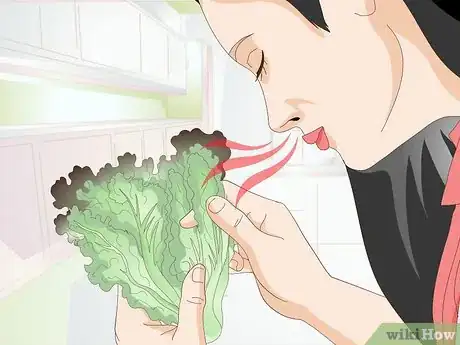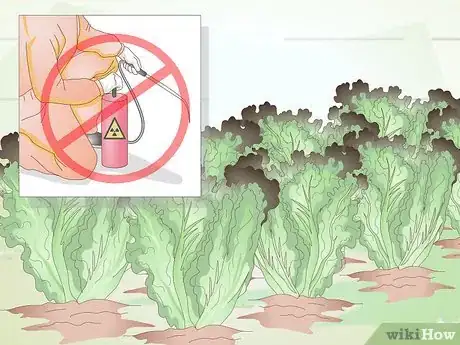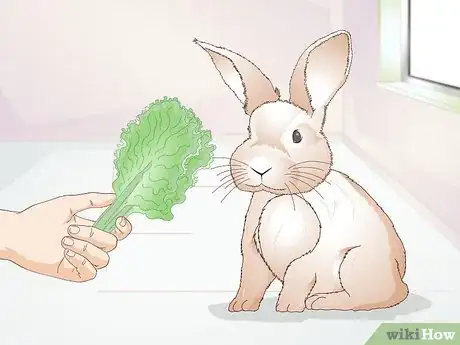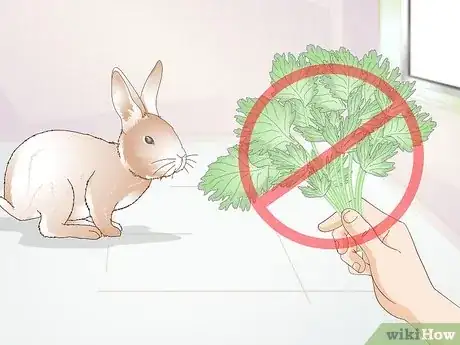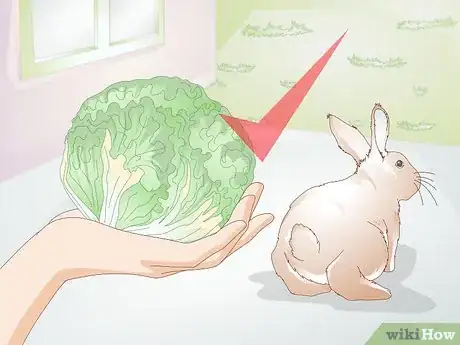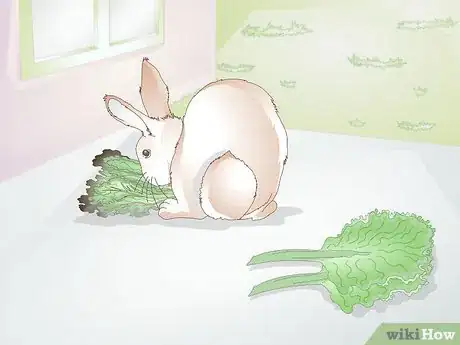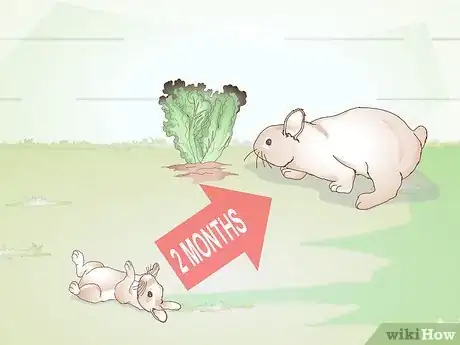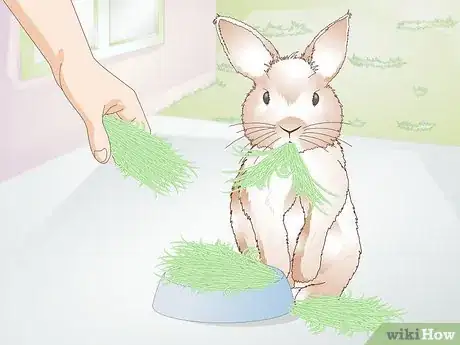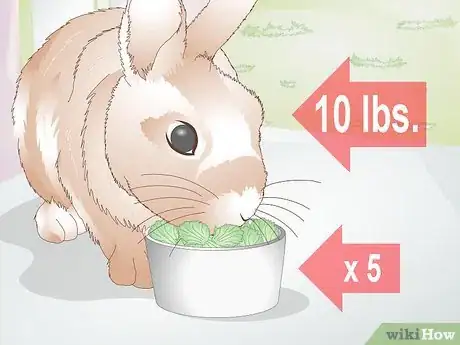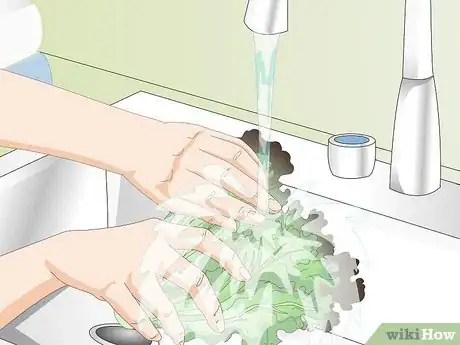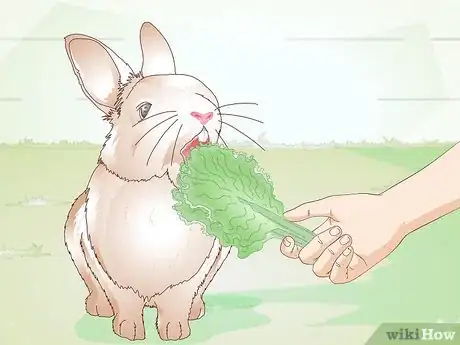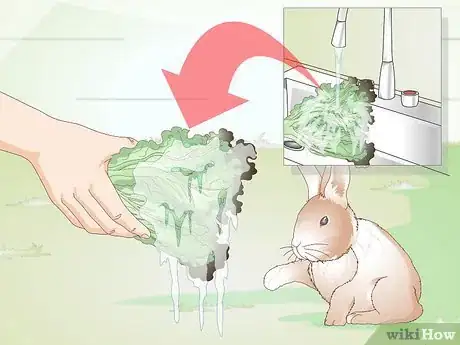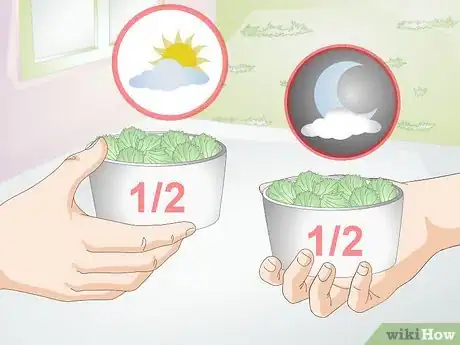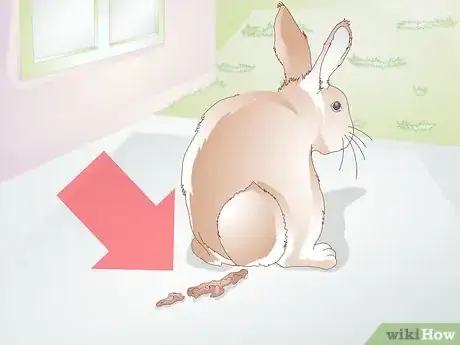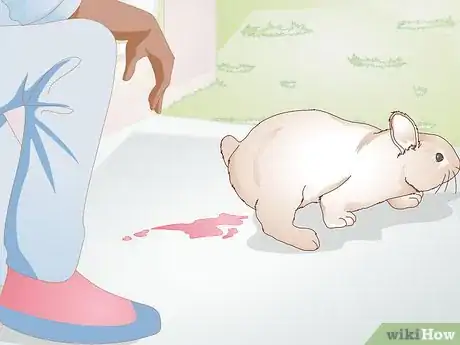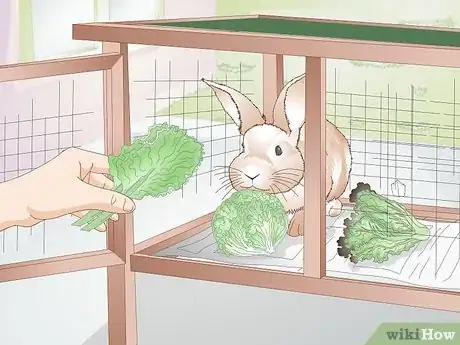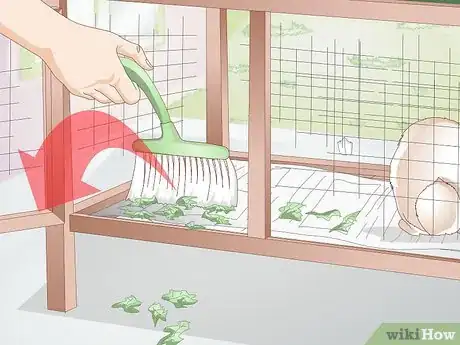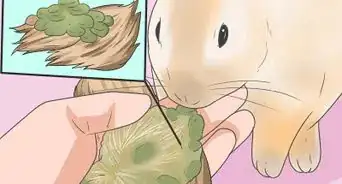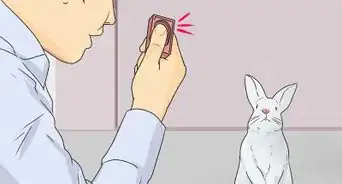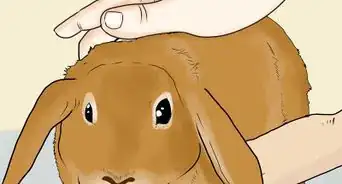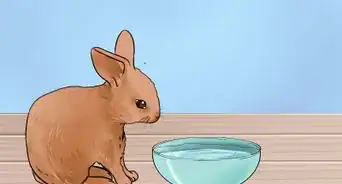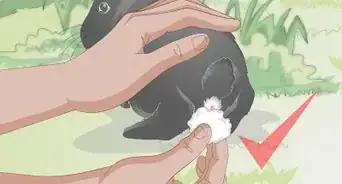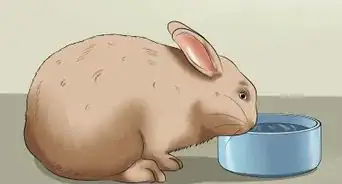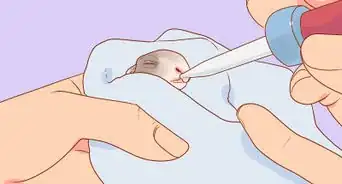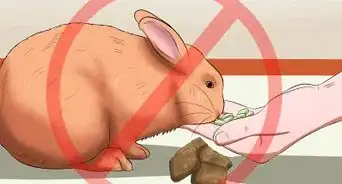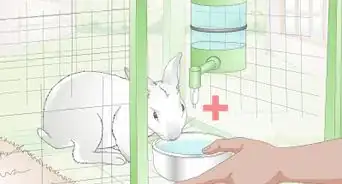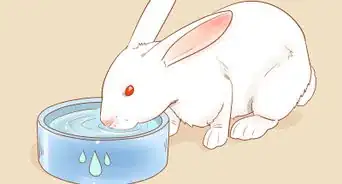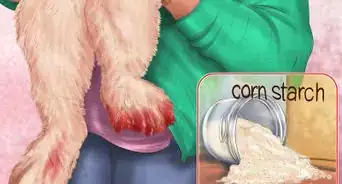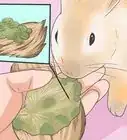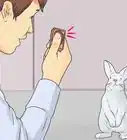This article was co-authored by Alisa Rassin. Alias Rassin is an Exotics Veterinarian and the Owner of The Exotic Animal Hospital of Pennsylvania in Lansdowne, Pennsylvania. With over a decade of experience, she specializes in treating reptiles, birds, and small mammals. She holds a Veterinariae Medicinae Doctoris from The University of Pennsylvania and a BS in Veterinary Biomedical and Clinical Sciences from Penn State University. She was also certified by the Royal College of Veterinary Surgeons.
There are 15 references cited in this article, which can be found at the bottom of the page.
This article has been viewed 59,006 times.
Greens are a very important part of a rabbit's diet. While a rabbit’s diet should consist primarily of grass hay, vegetables provide them with important nutrients that hay and pellets alone may not.[1] Introducing leafy greens slowly and carefully into your rabbit’s diet is the key to keeping it healthy and happy.
Steps
Providing Quality Greens
-
1Ensure your veggies are fresh. Spoiled veggies are bad for rabbits. In fact, rabbit stomachs are even more sensitive than human stomachs to rotting food. Check the texture and smell of your greens before feeding them to your hopping friend. If they feel excessively soft or spongy, or smell spoiled, do not feed them to your rabbit.[2]
- Red leaf lettuce, romaine lettuce, raspberry leaves, cilantro, dill leaves, bok choy, watercress, and wheatgrass are just some of the fresh greens your rabbit might enjoy.[3]
- You can try giving your rabbit other veggies as well. Just make sure to feed them a small amount one day and then offer a different veggie the next day. Never feed the same veggies two days in a row.
-
2Choose organic when possible.[4] Organic vegetables are grown without pesticides and harmful chemicals that can hurt your bunny. Buy organic greens when shopping to keep your rabbit healthy.Advertisement
-
3Keep the calcium content to a minimum. A high-calcium diet can cause bladder stones, urinary tract issues, kidney stones, and other digestive problems in bunnies.[5] Greens that are high in calcium like kale, mustard greens, and collard greens should be fed sparingly to your rabbit.
- If your pet seems exhausted, loses its appetite, assumes a crouched stance when urinating, urinates only in small trickles, or seems to be in pain while urinating, contact your vet. These are signs your pet might have consumed excess calcium.
- Broccoli, while not technically a green, is also relatively high in calcium and should also be fed in minimal amounts.
-
4Look out for greens with high levels of oxalic acid.[6] Oxalic acid can be consumed by rabbits in small amounts, but in high levels it can be toxic. Avoid giving your rabbit plants that are high in oxalic acid like parsley, mustard greens, and spinach.
- Try feeding your rabbit a green with high oxalic content like parsley for one week, then leave it out of the diet the next week.
-
5Avoid iceberg lettuce. This variety of lettuce contains a laudanum-like compound that can hurt your rabbit when consumed in excess. Choose dark, leafy lettuce types like red leaf and romaine to ensure your rabbit stays healthy.[7]
-
6Know your rabbit’s likes and dislikes. Each rabbit has a personality and its own unique preferences. While dandelion greens, for instance, might not bother one rabbit, they could cause another to have gas. Some rabbits like kale, while others do not. Always shape your rabbit’s diet in accord with what you know it likes.[8]
Preparing the Greens
-
1Wait until your rabbit is old enough to eat greens. Because young rabbits have sensitive and developing gastrointestinal tracts, they cannot eat fresh veggies for a little while after being born. Wait until your rabbit is about two months (8 weeks) old before introducing greens into its diet.[9]
- Keep in mind that rabbits are programmed to eat grass, shoots, and leaves, so don’t worry about giving them greens and veggies starting at 8 weeks old.
-
2Feed your rabbit grass hay. Before introducing greens or any other fresh food to your rabbit, it should eat some grass hay (as opposed to alfalfa hay) for at least two weeks.[10] With at least two weeks of grass hay in its system, your rabbit’s gut will more easily process and absorb the new greens.
-
3Decide what volume of greens your rabbit should eat. Rabbits should eat one cup of greens per every two pounds of its body weight each day.[11] For instance, if your rabbit weighs ten pounds, it should eat five cups of greens per day.
-
4Wash your veggies.[12] Vegetables often ship with pesticides coated on them. Even when you’re buying organic, your veggies might have been in contact with something yucky. Rinse your veggies in cool water over a colander before serving them to your rabbit.
- Do not use soap or other cleaning products to wash your greens.
Giving Your Rabbit Greens
-
1Introduce fresh greens slowly.[13] Don’t introduce a variety of new greens to your rabbit’s diet all at once. Instead, add one new type of green every two to three days. This way, if your rabbit has trouble digesting one or another of the greens, you’ll be able to easily identify which caused the problem.
-
2Serve your rabbit’s greens wet. After rinsing them off, there’s no need to wait for your greens to dry before feeding them to your rabbit. The extra moisture will help hydrate your bunny.[14]
-
3Feed half the greens in the morning and the other half in the evening. This is the best way to feed your rabbit. You could choose to feed all the greens at once and allow your rabbit to nibble on them throughout the day, but adding the greens to the rabbit hutch in two batches will keep the second batch fresh.
-
4Look for potential problems. Observe your rabbit and take note of anything out of the ordinary that could be a sign of health problems. For instance, if excessive or soft stool accompanies your rabbit’s consumption of a certain green, remove it from the diet and replace it with an alternative.[15]
- If a certain green is disagreeable to your rabbit, soft stools will develop within 24 hours of feeding your rabbit the new green.
-
5Check your rabbit’s urine after feeding a new green. Many greens (swiss chard, for instance) dye your rabbit’s urine red due to natural pigments in the plant. This is not harmful to the rabbit and should not be cause for concern. However, if you see sludgy or bloody urine, contact a vet immediately.[16]
-
6Try to feed a variety of greens.[17] Like people, rabbits will tire quickly of eating the same thing all the time. A mixture of greens will also ensure your rabbit gets a good balance of nutrients and vitamins. Ideally, each meal should have two or three different types of fresh greens.
-
7Remove uneaten veggies.[18] At the end of the day, remove any greens your rabbit did not eat. This will keep your cage clean and prevent bugs from gathering to consume the rotting produce.
Expert Interview
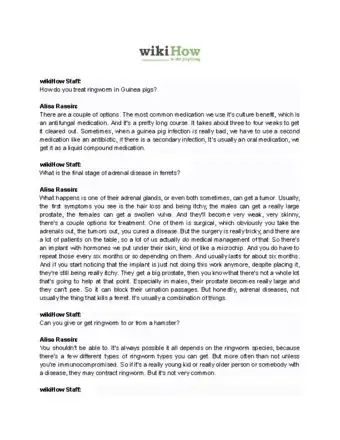
Thanks for reading our article! If you'd like to learn more about caring for a rabbit, check out our in-depth interview with Alisa Rassin.
References
- ↑ http://rabbit.org/suggested-vegetables-and-fruits-for-a-rabbit-diet/
- ↑ http://www.bio.miami.edu/hare/diet.html
- ↑ http://rabbit.org/suggested-vegetables-and-fruits-for-a-rabbit-diet/
- ↑ http://www.humanesociety.org/animals/rabbits/tips/rabbit_vegetables.html
- ↑ http://animals.mom.me/lowcalcium-vegetables-rabbits-2048.html
- ↑ http://rabbit.org/suggested-vegetables-and-fruits-for-a-rabbit-diet/
- ↑ http://www.rspca.org.uk/adviceandwelfare/pets/rabbits/diet/myths
- ↑ http://rabbithaven.org/diet/
- ↑ http://www.bio.miami.edu/hare/diet.html
- ↑ http://rabbit.org/suggested-vegetables-and-fruits-for-a-rabbit-diet/
- ↑ http://rabbit.org/suggested-vegetables-and-fruits-for-a-rabbit-diet/
- ↑ http://npic.orst.edu/capro/fruitwash.html
- ↑ http://rabbit.org/suggested-vegetables-and-fruits-for-a-rabbit-diet/
- ↑ http://www.bio.miami.edu/hare/diet.html
- ↑ http://rabbit.org/suggested-vegetables-and-fruits-for-a-rabbit-diet/
- ↑ http://rabbithaven.org/diet/
- ↑ http://rabbit.org/suggested-vegetables-and-fruits-for-a-rabbit-diet/
- ↑ http://www.peteducation.com/article.cfm?c=18+1798&aid=3579
About This Article
To feed your rabbit fresh greens, first wait until it is at least 8 weeks old and able to digest fresh vegetables before starting it on grass hay. After two weeks of eating grass hay, your rabbit’s gut will be able to easily process greens, and you should start giving it one cup of greens per every 2 pounds of body weight each day. When it comes to vegetables, give your bunny a variety of fresh, organic greens low in calcium and high in oxalic acid. For example, it might enjoy red leaf lettuce, cilantro, watercress, or wheatgrass, just make sure to thoroughly wash them in water before feeding your rabbit. For more tips from our Veterinary co-author, like how to look for negative effects of greens, scroll down.
